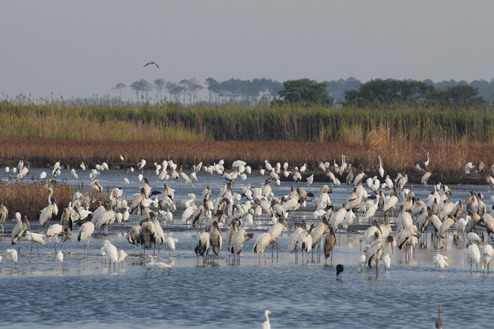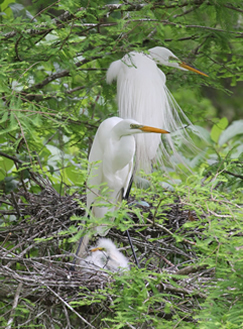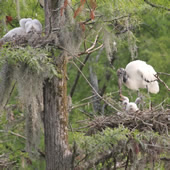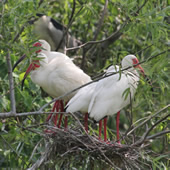Viewing Wading Birds in South Carolina
Nesting
Colonial wading birds can be adversely affected by human disturbance at their nesting colonies. When adults are flushed from their nests, eggs and chicks are vulnerable to predation and to exposure to adverse weather conditions. The breeding and feeding behavior of wading birds can be interrupted by disturbance. Additionally, wading birds may not utilize the best habitat available if they are regularly disturbed in these areas (e.g. storks may be deterred from nesting in trees near boardwalks). To protect nesting wading birds, some areas are closed during the nesting season. There are several areas where nesting wading birds can be observed by the public. At these sites, viewing areas are located at a great enough distance from the nests that disturbance is unlikely and/or the individual birds are acclimated to human activities.
At the Donnelley Wildlife Management Area, many species of nesting wading birds including storks can be observed from the dike near the office (please sign in and pick up a map at the kiosk). The colony is located at a great enough distance from the viewing area that the birds are not disturbed by visitors. A spotting scope is recommended for viewing birds on their nests. Nesting wading birds can be viewed up close at Pinckney Island National Wildlife Refuge. The birds at this site appear to be well acclimated to human visitation. The Dungannon Plantation Heritage Preserve is managed by SCDNR to provide nesting and foraging habitat for wood storks and other wading birds. The storks at this site are not acclimated to human disturbance, and the boardwalk is closed during the nesting season (typically March – August) to protect nesting storks.
Foraging
Wading birds in South Carolina forage in many types of aquatic habitat including impounded wetlands, natural wetlands, tidal creeks, ponds, and rivers. When water levels in impoundment wetlands are lowered, prey species are concentrated and large aggregations of foraging wading birds can be found. SCDNR manages thousands of acres of impounded wetlands for waterfowl, shorebirds, and wading birds at wildlife management areas in the coastal area of South Carolina. Particularly impressive aggregations for foraging birds can be found at Santee Coastal Reserve Wildlife Management Area, Bear Island Wildlife Management Area and Donnelley Wildlife Management Area.
The file above is provided in the Adobe® Acrobat® (PDF) format. Adobe® Reader® is required to open this file and is available as a free download from the Adobe® Web site.


SCDNR Wading Bird Program
585 Donnelley Dr.,
Green Pond, SC 29446, wadingbirds@dnr.sc.gov




